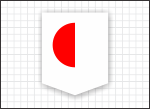How Silkscreen Printing Works April 15 2014

In it's simplest terms, the silkscreen printing process can also be refereed to as stenciling or serigraphy. Stenciling dates back thousands of years ago, some of the earliest examples can be found in the caves of France and Spain. Later on it was perfected to use silk for various designs in Japan and China. More recently it's been used to make Hawaiian shirts, and even playing cars in USA!
The first patent for a screen printing process was awarded to Samuel Simon of England, in 1907. Later, John Pilsworth of San Francisco perfect the multicolored screen printing. Throughout WWII, screen printing was used to make the famous "Uncle Sam" posters, and "U.S. Army Property" on soldiers' shirts. Marilyn Diptych (1962) by Andy Warhol, is arguably one of the most famous silkscreen paintings.
Compare different printing methods
Digital printing is basically done by any laser or an inkjet printer. It's a quick way to get your design made, whereas silkscreen printing takes longer because it uses actual buckets of paint to apply it to screens. Digitally printed stickers are not considered to be outdoor proof.
Lamination can also be added to digitally printed materials, this is meant to prolong the longevity. However, even so, the longevity of laminated digital stickers may only be measured in months.
Silkscreen printing process is the best way to make high grade, best possible quality stickers.
| Digital Print |
Laminated Digital Print |
Silkscreen |
|
| Resolution | High | High | Moderate |
| Setup time | Quick | Quick | Slow |
| Finish | Thin print | Thin print | Thick ink print |
| Outdoor life | Weeks | Months | 5+ years |
| Rain Resistance | Very Poor | Good | Best |
| UV Resistance | Poor | Poor | Best |
|
Tailribbons use |
 |
 |
 |
How silkscreen printing works
|
You start with a blank piece of a white vinyl with a sticky backing. By the way, you can also silkscreen print on fabrics like a t-shirt, glass, plastics, ceramics, even metal, wood, and of course paper.
|
|
A screen is a piece of fabric (traditionally silk, but now polyester is used) with thousands of tiny holes (polyester mesh). The idea is to get ink through the holes and unto the vinyl, but only in such a way that it creates your design. In other words, we don't need to utilize all of the thousands of tiny holes of the fabric (otherwise we end up with a red rectangle), but only the ones that make up our design. This can be done in several ways: |
|
Get a small bucket of red paint, and apply a layer of red ink by hand (with a squeegee) on the screen. |
|
This creates the red half of the circle. |
|
Force blue ink through the mesh of the screen "B", remove the screen, and so this creates the other blue half. |
|
In terms of quality, there's no comparison between digitally printed stickers and silkscreen printed ones. Always insist on silkscreen printing. |
- Gordon Roberts. (May 04, 2006). History's Influence on Screen Printing's Future. In ScreenWeb. Retrieved February 1, 2014, from http://www.screenweb.com/content/historys-influence-screen-printings-future.
- Screen printing - Wikipedia, the free encyclopedia. Retrieved February 4, 2014 from https://en.wikipedia.org/wiki/Screen_printing.

 Say for example you want to make a white tailribbon car sticker with a circle on it, and let's say this circle is half red, half blue.
Say for example you want to make a white tailribbon car sticker with a circle on it, and let's say this circle is half red, half blue. "Screens" are then created for each color in the sticker. Let's make a screen for the red color.
"Screens" are then created for each color in the sticker. Let's make a screen for the red color. Place this screen "A" we made in the step above onto the blank white vinyl.
Place this screen "A" we made in the step above onto the blank white vinyl. The ink is squeezed through the tiny holes in the screen and unto the vinyl.
The ink is squeezed through the tiny holes in the screen and unto the vinyl. Repeat likewise for the blue color, but with a different screen, "B".
Repeat likewise for the blue color, but with a different screen, "B". What you end up with is thick, quality raised ink (you can literally feel it) on your sticker.
What you end up with is thick, quality raised ink (you can literally feel it) on your sticker.